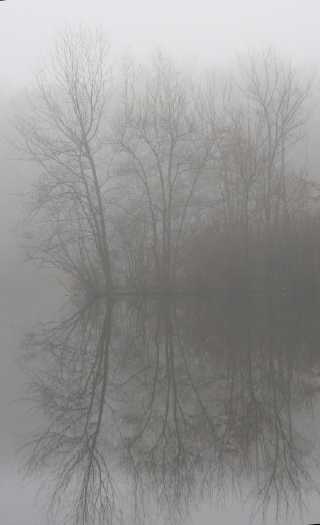

PHOTO COURTESY OF GARRY KESSLER
Foggy reflections of bare trees on Gilmore Pond are one of the rewards of a warm winter day. Gilmore Pond is a former farm pond and the headwaters of Jackstraw Brook. The pond is on the trail between Gilmore Farm Road and Isaac Miller Road, on the Charm Bracelet trail system.
January 12, 2007, Page 12
NATURE NOTES
By ANNIE REID
Westborough Community Land Trust
Think you know nature?
A year's end Nature Notes quiz
Thanks to this winter's unseasonably warm weather, the great out-of-doors has been much more accessible than usual for most of us. When the thermometer hit 65 degrees last Saturday, many Westborough residents were outside, doing chores in yards or walking sidewalks and trails. So far, at least, this is not our grandparents' winter.
Tune in to nature while you're outside this month. Heighten your awareness of who's who and what's what in our natural environment by taking this year's Nature Notes quiz, which reviews plants, animals, and other sights featured in this column in 2006.
As an added bonus, find out what you might see outside right now. An asterisk (*) marks quiz items dealing with sights that are available in the natural world in Westborough in January.
For spring, summer, and fall sights that aren't yet available, plan ahead to watch for them in the upcoming year. Remember, if our unseasonably warm weather continues, spring may really be right around the corner!
Below you'll find a list of short descriptions of plants, animals, and other sights from Nature Notes columns published in the News in 2006. Match these descriptions with the names in the list of possible answers that follows.
To check your answers, consult the Nature Notes Answer Key. It also lists the 2006 column that's relevant to each answer. Read past columns on the Westborough Community Land Trust web site at www.westboroughlandtrust.org/NatureNotes.php
If you – as an individual or a family – get all the answers correct (with no peeking!), or miss only one or two answers, email your name to us at NatureNotes@westboroughlandtrust.org . We'll publish a list of top scorers later this month. (You'll be helping us get an idea of how hard or easy this Nature Notes quiz was.)
Match these descriptions with answers from the list below:
*1. It goes head-first down tree trunks while searching for insects.
*2. This common critter stars in many stories and is famous for its reproductive rate.
*3. It's a feisty loner that hoard acorns.
*4. This caterpillar freezes and thaws during the winter, and its pattern is said to predict the winter weather.
5. On the first warm, rainy night of early spring, it sets out for a vernal pool to breed.
*6. This raw material for Native American spear points is found on one of two microcontinents that once collided along the Bloody Bluff Fault that runs through Westborough.
7. This garden visitor might be mistaken for a hummingbird, a bee, or a butterfly.
*8. It looks like a miniature pine tree and has giant ancient relatives that make up part of today's coal beds.
9. These tiny frogs with an X on their backs make a loud sound.
*10. These small wild ducks dive for fish and sport fan-like crests of feathers on their heads. The male's crest has a dramatic geometric pattern.
11. This mushroom digests itself into inky black goo and also traps and digests tiny underground roundworms.
*12. This aphid-like insect from Asia is attacking a native evergreen tree in town.
*13. This much-loved songbird is a conservation success story, thanks to volunteers throughout the country who set up and maintain a network of specially designed nest boxes.
*14. This sociable bird is fond of summer thistles.
15. It's another conservation success story, thanks to nest boxes on woodland ponds and laws regulating hunting.
*16. An unusual one of these is white and lives in town.
17. This late-season wildflower of wet places has the name of a reptile, and caterpillars of the Baltimore checkerspot butterfly feed on its leaves.
*18. It's usually seen swimming, but it's one of the heaviest flying birds in the world.
19. This small tan butterfly with orange spots on its wings lays eggs on the wild cherry trees in our woods.
*20. This night-blooming roadside wildflower is pollinated by moths.
*21. It travels in a nomadic flocks during most of the year, is good at finding dried wild fruit on trees in early spring, and doesn't sing.
*22. This wetland shrub has small yellow flowers and aromatic leaves and berries, and one kind of swallowtail butterfly lays eggs on it.
Possible answers:
-American goldfinch (Carduelis tristis)
-cedar waxwing (Bombycilla cedrorum)
-common evening primrose (Oenothera biennis)
-common spicebush (Lindera benzoin)
-coral hairstreak (Satyrium titus)
-Eastern bluebird (Sialia sialis)
-Eastern chipmunk (Tamias striatus)
-Eastern cottontail (Sylvilagus floridanus)
-Eastern gray squirrel (Sciurus carolinensis)
-hemlock woolly adelgid (Adelges tsugae)
-hooded merganser (Lophodytes cucullatus)
-hummingbird clearwing moth (Hemaris thysbe)
-mute swans (Cygnus olor)
-princess pine (Dendrolycopodium obscurum or Lycopodium obscurum)
-shaggy mane (Coprinus comatus)
-spotted salamander (Ambystoma maculatum)
-spring peeper (Pseudacris crucifer, formerly Hyla crucifer)
-turtlehead (Chelone glabra)
-Westboro quartzite
-white-breasted nuthatch (Sitta carolinensis)
-wood duck (Aix sponsa)
-woolly bear/Isabella tiger moth (Pyrrharctia isabella)
Go to Answer Key on page 19.
Date index
Month (January)
Common name index
Scientific name index
Category index